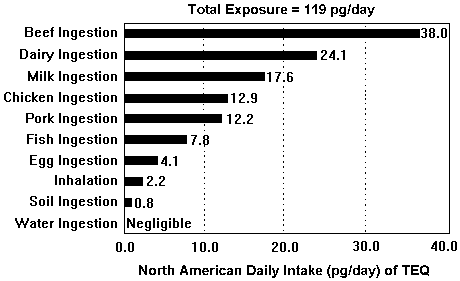Inter Press Services
Thu, Nov 20 1997
WASHINGTON, Nov. 20 (IPS) — Health experts long have warned of the
dangers of high-fat foods that can lead to heart disease or cancer. New
studies show that each fatty bite may also carry a dose of highly toxic
chemicals.
Man-made chemicals, including traces of
highly carcinogenic dioxins released into the environment, are turning up
in fast-food and grocery store staples such as meat, fish and dairy
products in industrialized countries at levels that exceed U.S. government
standards by 200 percent or more, according to the
studies.
“In industrialized countries you can
avoid the intake of dioxins, to a certain extent, by eating food that is
low in fat,” says Dr. Arnold Schecter, an international medical expert on
dioxins and an advisor to the World Health Organization (WHO). “But it is
more desirable to avoid producing dioxins in the first place. Developing
countries can avoid this problem completely if they do
not follow the same polluted industrialized path as we have.”
Dioxin is a toxic waste product formed when municipal
and hazardous waste is burned, and when chemicals containing chlorine, such
as pesticides and paper products, are manufactured. Once an
animal has eaten these toxic chemicals that are in the environment as a
by-product of industrialization and incineration, they accumulate in the fat.
WHO and the U.S. Environmental Protection
Agency agree that dioxins cause cancer.
Two recent studies on the subject
conducted by Schecter at the State University Health Science Center in
Binghamton, New York, have been published in the British journal
Chemosphere. He concludes that dioxins, and dioxin-like substances like
PCBs and furans, are getting into food supplies at levels that are highest
in high-fat foods, and lowest in low-fat foods such as fruits and vegetables.
“Besides cancer, minute amounts of these
chemicals have been shown to lead to nervous system and liver damage, as
well as to mimic hormones that disrupt reproduction and human development,”
says Schecter.
He points to a study in Japan and Taiwan
of persons who ingested rice oil that had been contaminated with PCBs and
furans during the 1960s and 1970s. They suffered from a combination of
higher cancer mortality, increased frequency of lung
infections, numbness and other nervous system effects.
“It is known that every person in every
industrialized country has dioxins in their blood…but since about 96
percent of the general population’s exposure to dioxins is through food, we
wanted to see if certain kinds of food contained more dioxins than others,”
Schecter said.
From ice cream and fish bought in the
grocery store to Kentucky Fried Chicken and McDonald’s Big Mac, all samples
collected from across the United States contained trace amounts of dioxin
that well exceed many government regulations, according to the studies.
While vegetables and fruits also
contained trace amounts of these chemicals, the dose was significantly
Less than high fat foods.
Advocacy groups such as the American
Public Health Association (APHA) believe that governments should be doing
more to protect people’s health, especially in light of these new
scientific findings.
“The U.S. government and many other
countries are not looking at the health effects of dioxin and other
synthetic chemicals that end up in our food,” says Richard Levinson, senior
policy analyst with APHA. “Food agencies are not carefully monitoring these
chemicals…we need a more consistent approach.”
Levinson says there should be a single
agency for food safety that is given adequate legal authority and resources
to monitor dioxin levels. Using the example of a pepperoni pizza, he says,
“The Food and Drug Administration is monitoring the
cheese while the Department of Agriculture monitors the pepperoni. They
do not collaborate on projects and usually do not compare their FDA is
underfunded as it is.”
Next summer, governments will negotiate a
global plan to phase out some of these chemicals at the United Nations
Persistent Organic Pollutants (POPs) convention.
Perhaps food labels could include dioxin
levels, says Michael Jacobson, executive Director of Center for Science in
the Public Interest, an advocacy organization. “Maybe consumers would begin
to eat less greasy fatty food if they were told how much dioxin was in each
serving.”
Developing fetuses and infants are most
at risk from the effects of dioxins, Schecter declares.
Birth defects, learning disabilities and
other development problems have been linked to dioxin exposure, according
to the studies. This is because these chemicals “mimic” or “block” estrogen
and progesterone, natural hormones which instruct the body on how it should
develop.
In just six months of breast feeding, a
baby in the United States will, on average, consume the EPA’s maximum
lifetime dose of dioxin, Schecter says. Breast milk contains high levels of
fat.
The amount of chemicals required to
disrupt normal development could be as low as one part in a trillion, he
says, the equivalent of a single drop of liquid placed in the center car
of a 10-kilometer long cargo train. Dioxins are also highly persistent in
the environment and extremely resistant to chemical or
physical breakdown.
Schecter, who has been involved with
dioxin and PCB studies in Russia, China, Cambodia, the Middle East, and
Vietnam as well as the United States, points to the widespread
contamination by dioxin. “From penguins in Antarctica to rains that fall in
South East Asia to the milk of a nursing mother in Germany, synthetic
chemicals have been found.”
Despite his gloomy conclusions, Schecter
remains hopeful that the problem can be overcome.
“For the most part, these synthetic
chemicals are historically new, they have only been around the later half
of this century. We must take every step to stop putting dioxins into our
environment and our food supplies. We can reverse this trend,” he says.
Chart from draft EPA Dioxin Reassessment:

Return to Dioxin
Return to Bovine Growth Hormone / Life Beyond Milk
Last modified: 27 November 1997
http://www.ejnet.org/dioxin/diet.html
